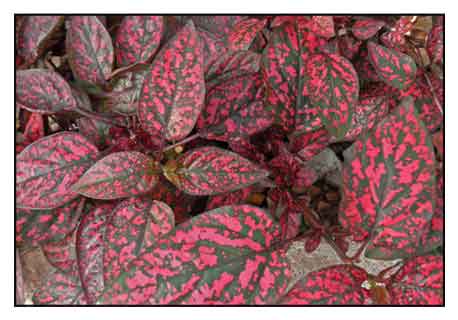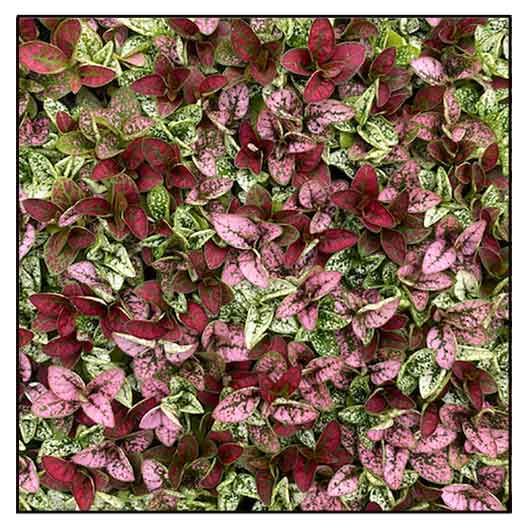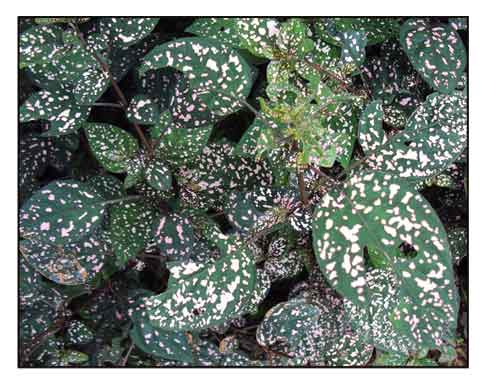 Gen info Gen info
- Hypoestes is a flower plant genus of about 150 species, widely distributed throughout the tropical and subtropical lands around the Indian Ocean
-
Hypoestes phyllostachya, the polka dot plant, is a species of flowering plant in the family Acanthaceae.
- The genus name Hypoestes derives from Greek 'hypo' meaning 'under', and 'estia' meaning 'a house', referring to the calyxes being covered by bracts. The specific epithet is Latin 'phyllostachya' meaning 'with a leaf spike'. (2)
- From the original type with pink spots on small, dark green foliage, today there are many colorful hybrids and cultivars
with splashes of bright red, white, shades of green, pink. Stems and branches may even be colored.
- In the UK, it has been granted the Royal Horticultural Society's Award of Garden Merit.
- Cultivars include: Carmina (bright red splotches on leaves); Confetti (smaller, 8 inches, more vigorous than other cultivars, in colors of white, pink, red, carmine rose, and burgundy red; often mixed); Pink Brocade (mottled with pink spots); Purpuriana (purplish leaves); Splash (large blothces of contrasting colors in pink, red, rose or white); Wit (marbled white leaves). (7)
 Botany Botany
Hypoestes phyllostachya is a small evergreen shrub growing to 30 cm (12 in) tall and broad. Leaves are ovate, dark green, opposite, pointed, up to 12 cm long and 8 cm wide, smaller higher up the stem, spotted with pink, rose, lavender or white on top, pale green underneath, covered with white hairs when young, less hairy when older, borne by petioles 2 to 4 cm on hairy stalks. Spots on the undersides of the leaves are far lighter in color, often white. Flowers are small, solitary, tube-shaped, 2 cm long, pink, purple or blue on terminal spike-like racemes up to 10 cm long forming at the end of stems. Stems are four-sided, branched, covered in long, white hairs. Fruit is a many-seeded, hairless, dehiscent capsule, 8-12 mm long, green to brownish when ripe. Seeds are usually 4 per capsule, 2-3 mm long. (8)
Distribution
- Introduced.
- Ornamental cultivation.
- Popular as an indoor ornamental house plant.
- Grows well in the Baguio area.
- Native to Madagascar.
- In some places, have escaped cultivation and seen growing wild.
- In south-eastern Queensland, listed among the top 200 most invasive plant species.
 Constituents Constituents
- Preliminary phytochemical screening of various solvent extracts of leaves showed most of constituents such as carbohydrates, proteins, steroids, fixed oils and fatty acids, flavonoids, alkaloids, saponins, tannins, and polyphenolics were present in the methanolic and aqueous extracts, with absence of volatile oils, terpenoids, and glycosides. (see study below) (3)
- Study of leaf and stem Hypoestes phyllostachya 'Rosea'
for volatile oils yielded 0.36 and 0.13%, respectively. GC-MS analysis yielded 38 compounds responsible for 99.86% of leaf oil, and 26 compounds making up 99.89% of stem oil. Of the identified compounds, 26 were in the leaf (93.43%) and 21 in the stem (90.45%). Leaf oil was dominated by sesquiterpenoids (69.37%), while the stem oil contained mostly sesquiterpene hydrocarbons (87.25%). Most abundant compounds in leaf oil are elemenone (20.04%), 8-cendren-13-ol (19.35%), 5-cendranone (10.60%), guaiol (4.43%), geranyl tinglate (4.30%), and germacrine B (4.21%). Prominent compounds in stem oil are viridiflorene (31.28%), allo-aromadendrene (14.65%), acoradiene (6.99%), -gurjunene (4.15%), and valencene (3.97%). (4)
- Study of aerial parts isolated three rearranged labdane-type diterpenoids, hypophyllins A-C (1-3), and a caged labdane diterpenoid possessing a 8,9-dioxatricyclic[4.2.1.13,7]decane moiety, hypophyllin D (4), as well as two new biogenetically related diterpernoids, hypophyllins E (5) and F (6). (see study below) (5)
Study of roots of H. phyllostachya 'Pink Splash' isolated 12 new ent-labdane diterpenoids, hypofolins A-F (1-6) and hypofolins G-L (7a/7b, 8a/8b, and 9a/9b). (see study below) (6)
Properties
- Studies have suggest antioxidant, vasorelaxant, cytotoxicity properties.
Parts used
Leaves, aerial parts, roots.
Uses
Folkloric
- No reported folkloric medicinal use in the Philippines.
- Species from the Hypoestus genus are used in several countries for various conditions, such as skin, eye, heart and liver diseases, malaria, anemia, typhoid, among many others.
- No specific folkloric use for H. phyllostachya found at this time.
Studies
• Antioxidant / Leaves: Study evaluated the phytochemical constituents and in vitro antioxidant activities of different solvent extracts of H. phyllostachya leaf. Antioxidant activities were assessed using DPPH, ABTS, hydroxyl radical, total antioxidant capacity, and reducing power assay. Results showed in vitro antioxidant activity confirmed by the different assays. (3)
• Vasorelaxant Activity / Hypophyllines / Aerial Parts: Study of aerial parts isolated three rearranged labdane-type diterpenoids, hypophyllins A-C (1-3), and a caged labdane diterpenoid possessing a 8,9-dioxatricyclic[4.2.1.13,7]decane moiety, hypophyllin D (4), as well as two new biogenetically related diterpernoids, hypophyllins E (5) and F (6). Compounds 4 and 5 showed potent vasorelaxant activity on endothelium-intact thoracic aorta rings precontracted with KCl. (5)
• Cytotoxicity / Hypophyllines / Roots: Study of roots of H. phyllostachya 'Pink Splash' isolated 12 new ent-labdane diterpenoids, hypofolins A-F (1-6) and hypofolins G-L (7a/7b, 8a/8b, and 9a/9b). Compound 1 showed weak cytotoxicity against SMMC-7721 cell line with IC50 of 31.40 µM. (6)
Availability
Ornamental cultivation.
|

![]()






